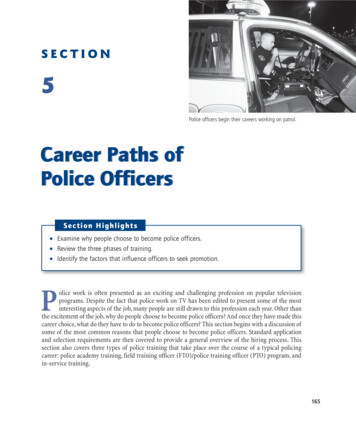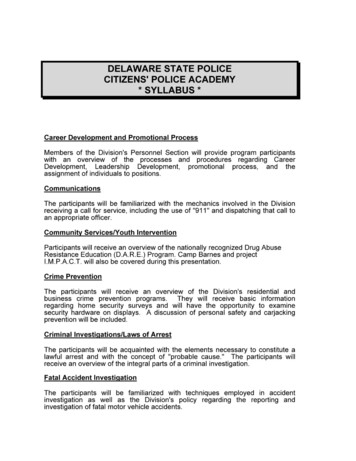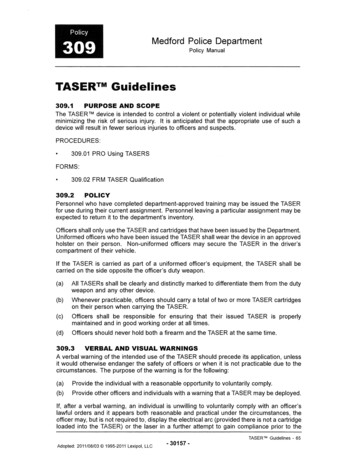
Transcription
Policy3()9Medford Police DepartmentPolicy ManualTASER Guidelines309.1PURPOSE AND SCOPEThe TASER device is intended to control a violent or potentially violent individual whileminimizing the risk of serious injury. It is anticipated that the appropriate use of such adevice will result in fewer serious injuries to officers and suspects.PROCEDURES:309.01 PRO Using TASERSFORMS:309.02 FRM TASER Qualification309.2POLICYPersonnel who have completed department-approved training may be issued the TASERfor use during their current assignment. Personnel leaving a particular assignment may beexpected to return it to the department's inventory.Officers shall only use the TASER and cartridges that have been issued by the Department.Uniformed officers who have been issued the TASER shall wear the device in an approvedholster on their person. Non-uniformed officers may secure the TASER in the driver'scompartment of their vehicle.If the TASER is carried as part of a uniformed officer's equipment, the TASER shall becarried on the side opposite the officer's duty weapon.(a)All TASERs shall be clearly and distinctly marked to differentiate them from the dutyweapon and any other device.(b)Whenever practicable, officers should carry a total of two or more TASER cartridgeson their person when carrying the TASER.(c)Officers shall be responsible for ensuring that their issued TASER is properlymaintained and in good working order at all times.(d)Officers should never hold both a firearm and the TASER at the same time.309.3VERBAL AND VISUAL WARNINGSA verbal warning of the intended use of the TASER should precede its application, unlessit would otherwise endanger the safety of officers or when it is not practicable due to thecircumstances. The purpose of the warning is for the following:(a)Provide the individual with a reasonable opportunity to voluntarily comply.(b)Provide other officers and individuals with a warning that a TASER may be deployed.If, after a verbal warning, an individual is unwilling to voluntarily comply with an officer'slawful orders and it appears both reasonable and practical under the circumstances, theofficer may, but is not required to, display the electrical arc (provided there is not a cartridgeloaded into the TASER) or the laser in a further attempt to gain compliance prior to theAdopted: 2011/08/03 1995-2011 Lexipol, LLC- 30157 -TASERTM Guidelines- 65
Medford Police DepartmentPolicy ManualTASER Guidelinesapplication of the TASER. The aiming laser should never be intentionally directed into theeyes of another as it may permanently impair his/her vision.The fact that a verbal and/or other warning was given or reasons it was not given shall bedocumented by the officer deploying the TASER.309.4USE OF THE TASERAs with any law enforcement equipment, the TASER has limitations and restrictionsrequiring consideration before its use. The TASER should only be used when its operatorcan safely approach the subject within the operational range of the TASER. Although theTASER is generally effective in controlling most individuals, officers should be alert to thepotential for failure and be prepared with other options.309.4.1FACTORS TO DETERMINE REASONABLENESS OF FORCEThe application of the TASER is likely to cause intense, but momentary, pain. As such,officers should carefully consider and balance the totality of circumstances available priorto using the TASER including, but not limited to, the following factors:(a)The qonduct of the individual being confronted (as reasonably perceived by the officerat the time).(b)Officer/subject factors (i.e., age, size, relative strength, skill level, injury/exhaustion,number of officers vs. subject(s).(c)Influence of drugs/alcohol (mental capacity).(d)Proximity of weapons.(e)The degree to which the subject has been effectively restrained and his/her ability toresist despite being restrained.(f)Time and circumstances permitting, the availability of other options (what resourcesare reasonably available to the officer under the circumstances).(g)Seriousness of the suspected offense or the reason for contact with the individual.(h)Training and experience of the officer.(i)Potential for injury to citizens, officers and suspects.U)Risk of escape.(k)Other exigent circumstances.309.4.2APPLICATION OF THE TASERAuthorized personnel may use the TASER when circumstances known to the individualofficer at the time indicate that such application of the TASER is reasonable to control aperson in any of the following circumstances:(a)The subject is violent or physically resisting.(b)A subject who, by words or action, has demonstrated an intention to be violent or tophysically resist and who reasonably appears to present the potential to harm officers,him/herself or others.(c)Absent meeting the conditions set forth in (a) or (b) above, or a reasonable belief thatan individual has committed or threatened to commit a serious offense, mere flightfrom pursuing officers shall not serve as good cause for the use of the TASER toapprehend an individual.Adopted: 2011/08/03 1995-2011 Lexipol, LLC- 30158 -TASER Guidelines- 66
Medford Police DepartmentPolicy ManualTASER GuidelinesWhen practicable, the officer should give a verbal warning of the intended use of the TASERfollowed by a reasonable opportunity to voluntarily comply.The officer must be able to articulate a reasonable belief that other available optionsappeared ineffective, impractical or would have presented a greater danger to the officer,the subject or others.309.4.3SPECIAL DEPLOYMENT CONSIDERATIONSThe use of the TASER should generally be avoided in the following situations unlessthe totality of the circumstances indicate that other available options reasonably appearineffective, impractical, or would present a greater danger to the officer, the subject orothers, and the officer reasonably believes that the need to control the individual outweighsthe risk of using the TASER:(a)(b)(c)(d)(e)Pregnant females;Elderly individuals or obvious juveniles;Individuals who are handcuffed or otherwise restrained;Individuals who have been recently sprayed with a flammable chemical agent or whoare otherwise in close proximity to any flammable material; orIndividuals whose position or activity may result in collateral injury (e.g. falls fromheight, operating vehicles).Because the application of the TASER in the drive-stun mode (i.e. direct contact withoutdarts) relies primarily on pain compliance and requires close proximity to the subject,additional caution should be exercised. The application in drive-stun mode should belimited to brief applications in which pain compliance would reasonably appear necessaryto achieve control.The TASER shall not be used to torture, psychologically torment, elicit statements or topunish any individual.309.4.4TARGETING CONSIDERATIONSWhile manufacturers generally recommend that reasonable efforts should be made to targetlower center mass and to avoid intentionally targeting the head, neck, chest and groin, it isrecognized that the dynamics of each situation and officer safety may not permit the officerto limit the application of the TASER darts to a precise target area. As such, officers shouldtake prompt and ongoing care to monitor the condition of the subject if one or more dartsstrikes the head, neck, chest or groin until he/she is released to the care of paramedics orother medical personnel.309.4.5ADDITIONAL TASER USE GUIDELINESOfficer shall not draw a TASER outside of a Medford Police Department facility, or inthe presence of any person in-custody without justification, except under the followingcircumstances:(a)(b)(c)Testing the TASER in a discreet location if it was not tested within the police facilities;Presentation to a supervisor for inspection; orSecuring weapons at the Jackson County Jail or other custodial facility.Justifiable drawing of the TASER from its holdster shall be thoroughly documented in anIncident or Arrest Report. TASER's record each weapon's discharge by date and time.Adopted: 2011/08/03 1995-2011 Lexipol, LLC- 30159 -TASERTM Guidelines - 67
Medford Police DepartmentPolicy ManualTASER GuidelinesSuch information shall be made available to any supervisor for audit or administrative reviewof an incident.TASER's shall be secured along with the officer's firearms at any custodial facility or otherlocation where officers are required to secure their weapons prior to entering the facility.Such facilities include the secure booking areas at the Jackson County Jail, Jackson CountyJuvenile Corrections, and Rogue Valley Medical Center Psychiatric Unit.309.4.6MULTIPLE APPLICATIONS OF THE DEVICEIf the first application of the TASER appears to be ineffective in gaining control of anindividual and if circumstances allow, the officer should consider the following beforeadditional applications of the TASER:(a)Whether the probes or darts are making proper contact.(b)Whether the application of the TASER is interfering with the ability of the individual tocomply.(c)Whether verbal commands, other options or tactics may be more effective.This, however, shall not preclude any officer from deploying multiple, reasonableapplications of the TASER on an individual.309.4. 7REPORT OF USEAll TASER discharges shall be documented in the related arrest/crime report, the TASERreport form and notification made to a supervisor in compliance with Policy § 300.4.1.Accidental discharges of a TASER cartridge will also be documented on the TASER reportform. Any report documenting the discharge of a TASER cartridge will include the cartridgeserial number and an explanation of the circumstances surrounding the discharge.The onboard TASER memory will be downloaded through the data port by a supervisor orFirearms Program Manager and saved with the related arrest/crime report. Photographs ofprobe sites should be taken, Anti-Felon Identification (AFID) tags should be collected andthe expended cartridge along with both probes and wire should be submitted by the officercollecting the cartridge into evidence for future reference. The cartridge serial numbershould be noted and documented on the evidence paperwork. The evidence packagingshould be marked "Biohazard" if the probes penetrated the subject's skin.309.5MEDICAL TREATMENTAbsent extenuating circumstances or unavailability, only qualified, trained personnel,including certified Sergeants, Master Police Officers and paramedics, should carefullyremove TASER darts from a person's body. Used TASER darts shall be considered asharp biohazard, similar to a used hypodermic needle. Universal precautions should betaken accordingly.Another uninvolved officer trained in TASER probe removal may remove the probes if aSergeant or Master Police Officer is not readily available. (Officers shall receive trainingannually on removal of TASER probes as part of use-of-force recertification.)If the TASER darts have penetrated a sensitive area (head I neck I groin I breast), theyshould be removed only by trained medical personnel.All persons who have been struck by TASER darts or who have been subjected to theelectric discharge of the device shall be medically assessed prior to booking. Additionally,Adopted: 2011/08/03 1995-2011 Lexipol, LLC- 30160 -TASER Guidelines- 68
Medford Police DepartmentPolicy ManualTASER Guidelinesany such individual who falls under any of the following categories should, as soon aspracticable, be examined by paramedics or other qualified medical personnel:(a)(b)The person is suspected of being under the influence of controlled substances and/oralcohol.The person may be pregnant.(c)(d)The person reasonably appears to be in need of medical attention.The TASER darts are lodged in a sensitive area (e.g., groin, female breast, near theeyes).(e)The person requests medical treatment.Persons who exhibit extreme agitation, violent irrational behavior accompanied by profusesweating, extraordinary strength beyond their physical characteristics, imperviousness topain (sometimes called "excited delirium"), or who require a protracted physical encounterwith multiple officers to be brought under control, may be at an increased risk of suddendeath and should be examined by qualified medical personnel as soon as practicable. Anyindividual exhibiting signs of distress after such an encounter shall be medically clearedprior to booking.If any individual refuses medical attention, such a refusal should be witnessed by anotherofficer and/or medical personnel and shall be fully documented in related reports. If an audiorecording is made of the contact or an interview with the individual, any refusal should beincluded if possible.The transporting officer shall inform any person receiving custody or any person placed ina position of providing care that the individual has been subjected to the application of theTASER.It should be recommended to the suspect to check personal medical records an updatetetanus immunizations when appropriate to do so.309.6TRAININGIn addition to the initial department-approved training required to carry and use a TASER,any personnel who have not carried a TASER as a part of their assignment for a period ofsix months or more shall be recertified by a department approved TASER instructor priorto again carrying or using the device. A reassessment of an officer's knowledge and/orpractical skill may be required at any time if deemed appropriate by the Training Coordinator.The Training Coordinator should ensure that all training includes the following:(a)(b)A review of this policy;A review of the Use of Force Policy§ 300;(c)Target area considerations, to include techniques or options to reduce the intentionalapplication of probes near the head, neck, chest, and groin;(d)De-escalation techniques; and(e)Removal of probes from non-sensitive areas as a result of a deployment.309.7ANNUAL AND BI-ANNUAL INSPECTIONSThe designated Less-Lethal Program Coordinator shall conduct a complete inspection andinventory of all Department TASER's annually and report to the Chief of Police via chain ofcommand. Such inventory may be conducted during monthly Department training.Adopted: 2011/08/03 1995-2011 Lexipol, LLC- 30161 -TASERTM Guidelines - 69
Medford Police DepartmentPolicy ManualTASER GuidelinesThe Defensive Tactics Program Manager shall inspect all TASER's and:(a)Conduct necessary service and maintenance;(b)Download the computerized history on each TASER; and(c)Re-set the internal time clock.Service and maintenance may be conducted during monthly Department training.Adopted: 2011/08/03 1995-2011 Lexipol, LLC- 30162 -TASERTM Guidelines - 70
U) Risk of escape. (k) Other exigent circumstances. 309.4.2 APPLICATION OF THE TASER Authorized personnel may use the TASER when circumstances known to the individual officer at the time indicate that such application of the TASER is reasonable to control a person in any of the following circumstances:
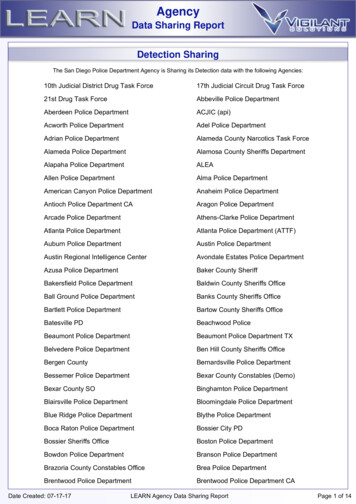
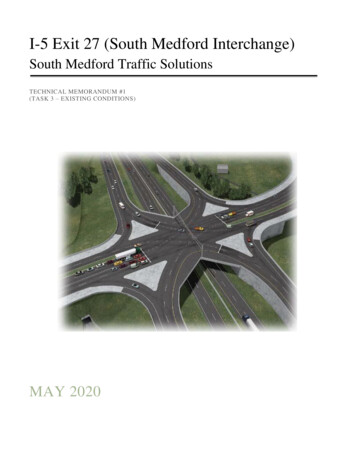
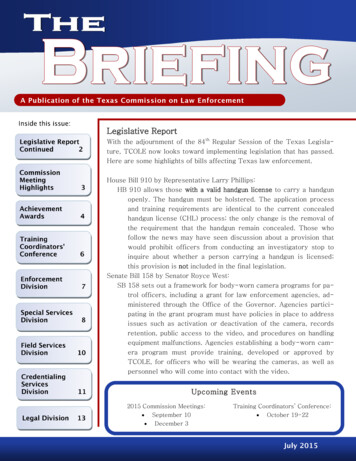


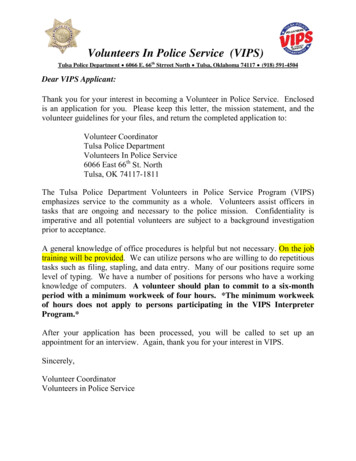
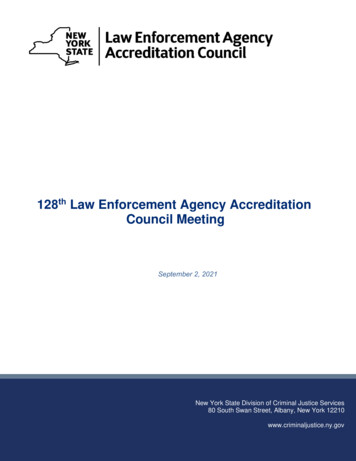
![Vohne Liche Kennels 6SHFLDOL]LQJLQ6WUR QJ6RFLDO3ROLFH'RJVµ](/img/38/reference-listing.jpg)
